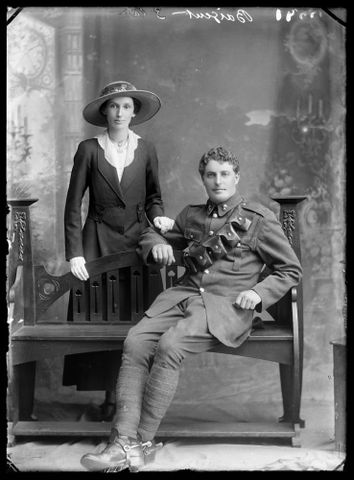The public interest following last month’s blog post was immense and extremely heart-warming. The reaction was helped along by an article in The Dominion Post on the 5 June entitled ‘Positive search via war negatives’ and an interview with Jim Mora on Radio New Zealand National. The emails, phone calls and letters poured in. As well as people seeking to find images of family members who were in World War One, there were others who were able to provide information about the soldiers and a few people have offered ongoing assistance. This response has proven to me that there is a huge amount of interest and a hunger for information about people’s experiences during World War One, and that the images and the stories behind the images are fascinating and compelling.
One very exciting outcome was when a relative of Harold Batten, pictured below, recognised the photo in the Dominion Post article and rang to add new information.

Harold was 24 years old when he commenced service on 5 January 1917. At this time he lived in Otaki and was a horse trainer and jockey.
He left Wellington on a ship named the ‘Pakeha’ in April 1917. This young fresh-faced man was about to be engaged in one of New Zealand’s most catastrophic and tragic battles of all time, killing thousands men. Harold’s unit endured Passendale in October 1917, but he survived. Harold was wounded by ‘high explosive’ shell on 12 October 1917. He received a wound to his lower left forearm and was hospitalised. Once he was well enough, Harold returned to New Zealand.
Harold survived the war and according to his niece, he lived a long and happy life. He married Bessie Olive Taylor in 1918 and they had two children, Patricia and Ernest. He lived in Hamilton until the age of 61.
Another negative with the name Baigent etched on it was an unsolved case last month, but with the help of Iain Davidson, a sheep farmer with a special interest in military history, the sitters’ have been reunited with their identities.

The woman and soldier above have now been identified as Annie (nee Packard) and Ashley Heath Baigent. Ashley was a farmer from Takaka, just like Iain. Although there is no family connection between Iain and Ashley they shared similar lives.
Ashley’s war story is quite a short one. He attested for service in 1917, was assigned to the New Zealand Field Artillery’s 25th Reinforcements but was found to have a goitre and therefore ‘unfit for active service’.
I’d like to end this month’s blog by drawing attention to the high death rate of soldiers caused by influenza. Even though I was aware that the influenza epidemic that swept through New Zealand caused the death of thousands of healthy people, I was surprised by the number of soldiers I have come across that died from it. One example, Private James Frederick Carnes of the 40th Reinforcements, became ill on his journey to the Great War in 1918. He died of influenza and was buried at sea.
These men were exceptionally fit and healthy. Who would have guessed their fate would be to die of the flu. Another example I came across was William Anderson, pictured below with his mother Marion. He attested for service in January 1918, only 20 years old. He had been living in Westport and working as a purser for the Union Steam Ship Company. His mother and father lived in Wellington and he had a brother George and sister Janet.

He embarked on the Tofua from Wellington, 22 May 1918 as part of the 42nd Reinforcements, C Company. Two months later while training at the Cannock Chase army camp in Staffordshire, England he died of ‘pneumonia’ probably caused by the Spanish Flu epidemic which was rife there. He is buried at the Cannock Chase War Cemetery.
All of the people in these images have a unique story to tell about their lives during World War One. If you think that you might have something to contribute please visit our new Flickr site Kiwi Faces of War which will enable you to view all of our soldier portraits (arranged alphabetically) and add comments and information.
We are regularly updating and adding to the Te Papa records. For the most up-to-date information on each image go to Collections Online


Military servicemen, war veterans and their families from different parts of the world go through tough efforts in finding military records needed in processing various documentations and claims. New Zealand is a country where many brave men and women, civilian or military have served during the war. Website : http://army-records.net/new-zealand-army-records/
My great uncle, William FLEMING, Private 32511 died in WW1, 18th August,1917. He had been employed by the Dominion before he left for overseas. William was 36. According to his army records he is buried in Mud Corner British Cemetery, Comines-Warneton, Hainaut Belgium. Grave Reference II.E.2. I would be interested to see if he had a photo taken before he went overseas. His next of kin was Percy James FLEMING (brother)Govt. Print Wellington also Mrs G CARDE, Wanganui (sister).
Hi Josie, Thanks for you email. There is a ‘Fleming’ in the Berry photos. I have attached a link so that you can have a look. Please let us know if you recognise anyone: http://collections.tepapa.govt.nz/search.aspx?term=Berry Fleming
Thanks, Lynette
Thank you Lynette.
There was nothing there that was my William Fleming. I thought that there would be very few records, they were a very poor family. He was the eldest boy of 8 children two of whom were put in an industrial school because they stole a box of tea after their father died.
Thank you
Josie Snook